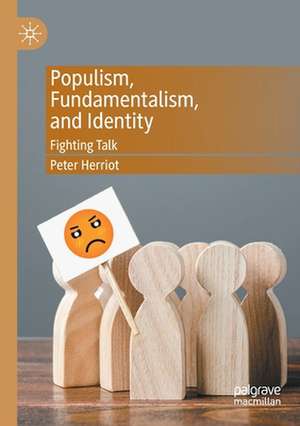Populism, Fundamentalism, and Identity: Fighting Talk
Autor Peter Herrioten Limba Engleză Paperback – 9 apr 2021
What can populism and fundamentalism possibly have in common? Peter Herriot argues that contrary to their apparent differences, these human phenomena are similar in two basic respects. First, they are both reactions against the complexities of the modern world in general, and its current crisis in particular. They propose instead a return to a mythical golden age, supposedly marked by purity and simplicity. Second, they both work in the same way psychologically. Using social identity theory, Herriot shows how both populism and fundamentalism create constant conflict by contrasting a virtuous ‘Us’ with a stereotypically evil ‘Them’. Contemporary case studies illustrate this process at work, and Herriot raises various issues as a basis for discussion, and concludes with hope.
| Toate formatele și edițiile | Preț | Express |
|---|---|---|
| Paperback (1) | 379.30 lei 6-8 săpt. | |
| Springer International Publishing – 9 apr 2021 | 379.30 lei 6-8 săpt. | |
| Hardback (1) | 385.47 lei 6-8 săpt. | |
| Springer International Publishing – 9 apr 2020 | 385.47 lei 6-8 săpt. |
Preț: 379.30 lei
Nou
Puncte Express: 569
Preț estimativ în valută:
72.59€ • 75.69$ • 60.33£
72.59€ • 75.69$ • 60.33£
Carte tipărită la comandă
Livrare economică 20 martie-03 aprilie
Preluare comenzi: 021 569.72.76
Specificații
ISBN-13: 9783030425111
ISBN-10: 3030425118
Pagini: 157
Ilustrații: VIII, 157 p.
Dimensiuni: 148 x 210 mm
Greutate: 0.21 kg
Ediția:1st ed. 2020
Editura: Springer International Publishing
Colecția Palgrave Macmillan
Locul publicării:Cham, Switzerland
ISBN-10: 3030425118
Pagini: 157
Ilustrații: VIII, 157 p.
Dimensiuni: 148 x 210 mm
Greutate: 0.21 kg
Ediția:1st ed. 2020
Editura: Springer International Publishing
Colecția Palgrave Macmillan
Locul publicării:Cham, Switzerland
Cuprins
Introduction.- Chapter 1. What’s the issue? Modernity, reaction, and self.- Chapter 2. What are they? Populism and fundamentalism- Chapter 3. Who am I? The self.- Chapter 4. Who are we? Social identity.- Chapter 5. Who are they? The other.- Chapter 6. What’s the story? Fighting talk
Chapter 7. Who’s in charge? Leaders and led.- Chapter 8. What’s the secret? The role of technology.- Chapter 9. What to do? Common sense solutions.- Chapter 10. Prescriptions or pressure points?.- Chapter 11. When reality dawns.- Chapter 12. When ‘Us’ cracks up.- Chapter 13. When ‘They’ answer back.
Notă biografică
Peter Herriot was Professor of Organizational Psychology in the UK. Since retirement he has applied social and organizational psychology to religious fundamentalism, having himself been brought up in a fundamentalist family. His recent books include Religious Fundamentalism: Global, Local, and Personal (2008) and The Open Brethren: A Christian Sect in the Modern World (2018).
Textul de pe ultima copertă
What can populism and fundamentalism possibly have in common? Peter Herriot argues that contrary to their apparent differences, these human phenomena are similar in two basic respects. First, they are both reactions against the complexities of the modern world in general, and its current crisis in particular. They propose instead a return to a mythical golden age, supposedly marked by purity and simplicity. Second, they both work in the same way psychologically. Using social identity theory, Herriot shows how both populism and fundamentalism create constant conflict by contrasting a virtuous ‘Us’ with a stereotypically evil ‘Them’. Contemporary case studies illustrate this process at work, and Herriot raises various issues as a basis for discussion, and concludes with hope.
Caracteristici
Applies social identity theory to populism and fundamentalism simultaneously Demonstrates the usefulness of identity in understanding movements which would normally be analyzed separately Written for scholars of religious studies, politics, sociology, and social psychology
